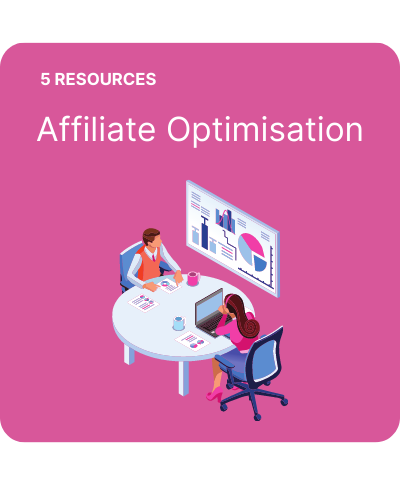Affiliate Marketing Metrics
All successful digital marketers use data to analyse the success of their campaigns. The affiliate marketing channel should be no different.
The beauty of the affiliate marketing channel is performance is based on results. Unlike PPC or Paid Social, the commission model means a cost is incurred only when an order is placed.
To scale and run a successful affiliate program though, we need to be looking a various metrics, not just orders.
With that in mind, here are the top 14 most important affiliate marketing metrics to monitor for your program.
1. Clicks
It is crucial for the advancement of an affiliate program to have a steady stream of targeted traffic coming to your site.
Without this metric, the majority of others would become obsolete, which makes this very important, especially for recently launched programs.
The affiliate channel is not typically something brands can switch on, then a flurry of orders come through. With an effective pre-launch plan, that becomes more feasible. But, getting traffic to your site will be key at the beginning.
Over time, this is a metric you can use to manage any new affiliates that join your program. In addition, it is a clear indicator of potentially fraudulent activity should it be abnormally high.
2. Revenue
The common goal for brands and their affiliates is to make more revenue. With commission as a percentage of revenue the main payout model. It is in a publishers interest to generate more revenue for a brand to earn higher commissions.
At the end of the day, this is the metric senior management wants to see. They aren’t too concerned about the nuances that went into the performance, just how much revenue was generated.
It is always positive to have a revenue target for your program. But, is it an achievable goal? What does it look like as a percentage of online sales and what will it cost you to hit this target?
Setting the right goals will help you manage expectations for your program. It will also ensure you are targeting the right type of affiliates when recruiting to achieve it.
3. AOV
While many marketers look to traffic, conversion rates, and orders as a measure of how successful their affiliate program is. It is the Average Order Value (AOV) that could be the secret weapon in supercharging your affiliate channel.
A high AOV can be a great indicator that you are sending a good mix of targeted traffic to your site. If it is low this could mean the traffic is not too convinced by your brand or products and are putting in a low order value to test you out.
AOV is perfect for increasing performance. Because by getting the same customers to spend a bit more it could result in a lot more revenue. Use tactics like basket level discounts or cashback to encourage customers to add an extra item into their basket.
Having a strategy to increase your AOV or maintain a high one, is something I would recommend to all brands with affiliate programs.
4. Conversion rate
Conversion rate is the percentage of traffic that purchased from your site. I like to monitor this metric on a channel level but also on an affiliate level.
If you can identify a publisher that has a high conversion rate. There is a good chance that they have a very engaged audience. Take advantage of this and do more activity with them to drive more of this high converting traffic to your site.
On paper, an affiliate program could be generating a ton of traffic. But, without the conversion rate, there is no guarantee that any of those clicks will turn into orders.
Find ways to maintain and boost conversion rates. It could be through coupon led activity or even creating co-branded landing pages. Both have been proven to improve conversion rates.
5. ROI
As affiliate managers, we can often be swept up in the success of an affiliate program by focusing on the top-line revenue.
Without a firm grip on the programs ROI, there is no way of seeing if that revenue is sustainable.
You could keep your ROI basic and just include revenue divided by commissions. But, I believe it is important to also include all management and network costs. That way you can see what the channel is truly delivering versus the cost of running it.
On a granular level, ROI is one indicator you can use to analyse the success of an individual publisher campaign. When you start paying for media placements, the pressure to deliver revenue with a strong ROI becomes more paramount.
6. Impressions
An undervalued asset in the affiliate managers toolkit is the banner. Often, generic assets are uploaded into the dashboard and only changed once or twice a year.
If your publisher has a good mix of bloggers, then banners and the impressions generated on them should be something to consider.
Banners don’t necessarily lead to orders, though this can be improved. Working with content partners to create assets tailored to them can improve click-through rates and potential orders.
7. Assisted orders
Network technology has come a long way over the past few years. Both affiliates and brands have the opportunity to gain more insight into performance than on just a traffic or order level.
One of these new metrics to be introduced on a number of affiliate networks is assisted orders. This is the number of orders whereby the partner might have been the first or second click for the customer but not the last. As the industry is typically a last click wins model for earning commission, the assisted partner would miss out on earning any reward.
This assisted metric can give us a greater view of affiliates that might be having their cookie overwritten. But, also the partners that might continually not be rewarded for their participation in the customer journey.
Armed with this assisted conversion data, affiliate managers are able to launch strategies or incentives to reward partners no matter their position within the customer journey. This would help to tip the scales away from the coupon and cashback sites that hoover up customer orders. Thus creating an affiliate ecosystem that compensates based on touchpoints, not just a last-click conversion.
8. Attributed orders
In addition to the assisted orders metric, you might see in your affiliate network that you can see orders that have been attributed to other channels.
This is crucial to understanding the full online digital space and how different channels interact with others.
A high number of sales assisted to other channels should lead to a further investigation. Are the first click and last click far apart and how many channels were involved in the purchase?
How you attribute your digital marketing activity can be directly linked to budgets and targets. By knowing more about the part affiliates play in purchase behaviour can help model your attribution correctly. The result could be a chance to increase spend in the channel to reward your partners fairly.
9. Commission category
To begin with, an affiliate program might only be launched with just a default commission rate. That is one commission rate no matter what is purchased on the brand’s site.
In order to maximise ROI and protect margins, I would recommend introducing different commission terms. This could be a lower rate for sale items or discount items where margins have been affected by the reduced RRP.
Track the performance of each commission category on a weekly or monthly basis. It may help you to spot opportunities with affiliates to push certain categories or promotions more than others.
This structure could also help dispel myths around the channel as well. For example, I often find that my coupon partners are able to drive a huge volume of full-price orders not just discounted ones.
10. Earnings Per Click
Something that many networks call out on a brand by brand basis, EPC could be an indicator of success for those looking to join your program.
The lower the EPC, the less an affiliate will make from the traffic they send to your site. This metric can then be used as a baseline to compare you against other similar brands or your vertical as a whole.
There is no magic number your EPC should be. Just compare to those around you and see how you stack up.
Remember, this metric can always be improved by boosting conversion rates or AOV, offering higher commission and declining fewer orders.
11. Average commission rate
Setting up the right commission rates can be crucial in engaging and optimising our affiliate partners. Although, this won’t always tell the full story of what a particular affiliate might be earning.
In exchange for additional placements, brands will offer increased commission rates. If these are not tracked over the long term, it could lead to budgets being blown.
One way you could summarise this is by including any media costs for placements as well. That way you can set a blended commission/tenancy rate for partners. Sharing this with the affiliate can ensure you both have a target to work to and coverage can be tailored according to current performance.
12. Active affiliates
All affiliate programs can differ in size. Some may only have a handful of partners, others might have thousands. The active partner metric can be a useful tool to monitor affiliate engagement no matter the number of partners you have.
In the channel, there is often an 80/20 rule touted. That is 80% of your affiliate revenue comes from 20% of partners. This is due in part to the size of certain partners but also where our time is spent. As affiliate managers, we tend to gravitate towards the partners driving the most orders.
But, if we look at active affiliates as a measurement this can help broaden our horizons. This metric is the percentage of affiliates driving clicks or orders for your brand. The key is to increase this as much as possible as it is a sign of an engaged program.
Build out strategies that reward affiliate participation in the customer journey and incentivises more partners to promote your brand.
13. Decline rate
A lot of brands are guilty of taking advantage of the affiliate validation process. Unlike other channels, because we are paying on an order rather than an upfront click or impression. There is always the option to decline a sale should you want.
It goes without saying that if a customer returned an order, cancelled or paid fraudulently. Then no commission should be paid to the partner.
High decline rates are a red flag to affiliates joining your program. They can also be detrimental to those affiliates that are inputting an upfront cost to generate traffic or orders for a brand.



